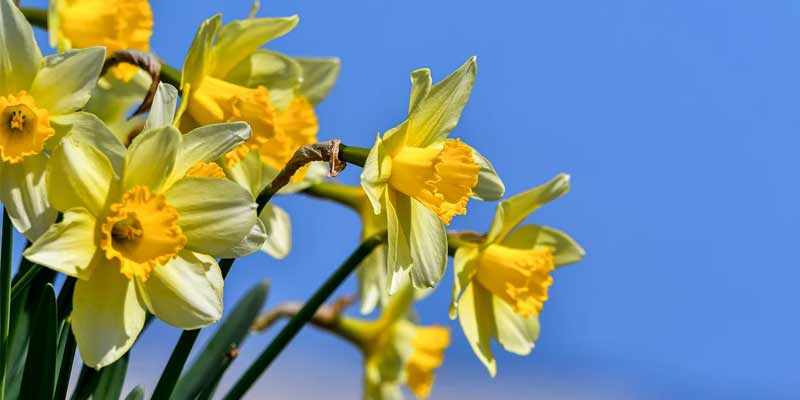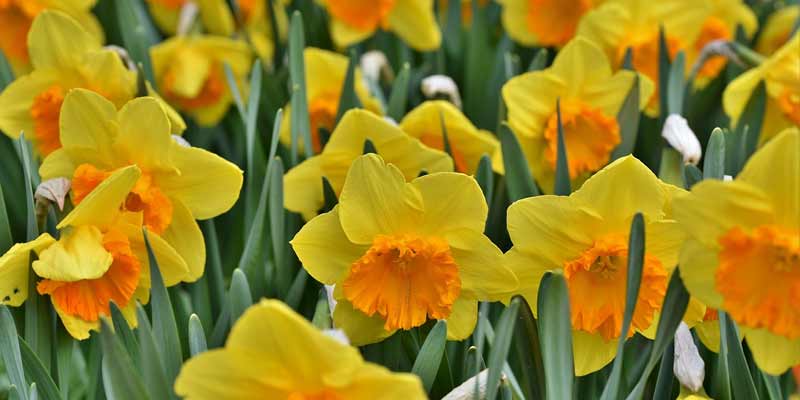Winter’s icy grip loosens, and the earth awakens from its slumber. Nature adorns herself in vibrant hues to announce spring’s arrival. Daffodils stand as stalwart harbingers among a myriad of blossoms painting landscapes with delicate petals; their golden trumpets and verdant stems pierce through thawing soil – a sight that brings joy and hope to witnesses. But when exactly do these cheery flowers bloom, and what factors influence their timing?
Early Indicators: The Physiology of Daffodils
Scientifically identified as Narcissus, daffodils are perennial bulbs in the Amaryllidaceae family; their bloom usually occurs during spring.
However, several factors can influence the precise timing of this period. Comprehending the physiological processes that control daffodil growth illuminates the intricacies within their bloom cycle.
Daffodil bulbs awaken from dormancy as temperatures gradually rise; daylight hours lengthen. Within the soil’s depths, roots extend anchoring the plant and absorbing vital nutrients. Meanwhile, stored energy reserves within the bulb fuel shoot growth: a synchronized rejuvenation process.
Known as scapes, these shoots ultimately breach the surface, they serve as a herald for the impending arrival of the flower.
Nature’s Symphony: Environmental Influences
Daffodils, possessing an intrinsic biological rhythm, have their bloom timing significantly dictated by external environmental factors. Among the key influencers is temperature since daffodils necessitate a chilling period, referred to as vernalization to initiate flowering; this underscores the importance of ambient thermal conditions in regulating botanical blossoming processes.
To ensure the bulbs remain dormant during winter and prevent premature growth, this chilling requirement is crucial. Once they experience a sufficient duration of cold temperatures – typically between 12 to 16 weeks, contingent upon their variety – their exposure primes them for flowering when warmer conditions prevail.
Daffodils also perceive day length as a crucial cue; with the approach of spring and the subsequent increase in daylight hours photosynthetic activity intensifies.
This intensification supplies the energy required for floral development, which longer days serve as signals to these plants, prompting them to shift their focus from vegetative growth toward reproductive processes. Consequently, this heralds an emergence of flower buds.
Additionally, soil moisture levels exert an influence on the bloom times of daffodils. Bulb development and root establishment hinge critically upon adequate moisture.
Yet, when conditions become excessively waterlogged, this can trigger bulb rotting; a notable impediment to growth that could potentially delay flowering. Prolonged drought periods, in contrast, may stress plants and compromise their capacity for producing vigorous blooms.
Varietal Variations: Diverse Blooming Schedules
A vast array of cultivars, each with unique characteristics including bloom time, make up the world of daffodils. ‘February Gold’ and ‘Tête-à-Tête’, among the early-blooming varieties often grace gardens as early as late winter; they thrive in cooler climates and their ability to brighten dreary landscapes are highly prized.
Following closely behind are mid-season daffodils like ‘Ice Follies’ and ‘Carlton’, which typically bloom in early to mid-spring. Their vibrant flowers align with the peak of the season’s floral display; they paint gardens and parks in colorful splendor.
Late-blooming varieties such as ‘Pink Charm’ and ‘Thalia’ then take over, extending the daffodil season into late spring to ensure a continuous spectacle of blooms before summer begins.
Cultural Considerations: Planting Practices
Cultural practices, particularly planting methods, can also influence the timing of daffodil bloom. Typically in fall, people plant daffodil bulbs to allow ample time for root establishment before winter begins. The emergence of these bulbs may vary depending on their planting depth; deeper placements often yield delayed flowering events.
Moreover, the division and transplanting of bulbs may disturb their natural cycle; this could potentially delay bloom time as plants adjust to new conditions.
The Dance of Spring: A Spectacle to Behold
The lengthening days and rising temperatures set the stage for nature’s grand performance; daffodils timelessly elegant, enduringly charming command center stage in this seasonal symphony.
From spring’s earliest whispers to its final crescendo, their radiant blooms captivate hearts and minds, an eloquent reminder of both beauty and resilience within our natural world.
Conclusion
Conclusively, a delicate interplay of biological processes and environmental cues governs the timing of daffodil bloom. Their emergence signifies spring’s arrival; however, factors such as temperature, day length, soil moisture – even varietal characteristics – can cause variation in this precise timing.
Daffodils unfailingly inspire awe and wonder whether they bloom early in spring’s cycle or wait until its midpoint, their existence symbolizes rejuvenation, the promise always kept by each new season.



Leave a Reply